Calanda | |
|---|---|
 | |
 Seal | |
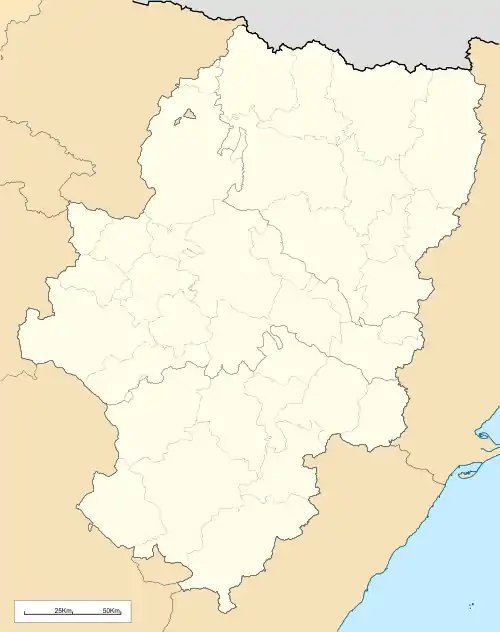 Calanda Location in Aragon 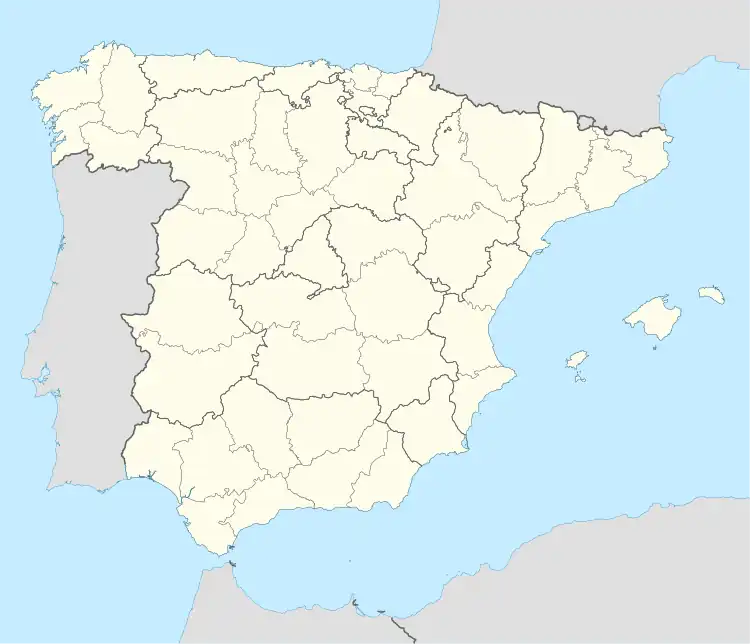 Calanda Location in Spain | |
| Coordinates: 40°56′27″N 0°13′54″W / 40.94083°N 0.23167°W | |
| Country | |
| Autonomous community | |
| Province | Teruel |
| Comarca | Bajo Aragón |
| Government | |
| • Mayor | José Ramón Ibáñez Blasco (PSOE de Aragón) (2015–2019) |
| Area | |
| • Total | 112.25 km2 (43.34 sq mi) |
| Population (2018)[1] | |
| • Total | 3,708 |
| • Density | 33/km2 (86/sq mi) |
| Demonym | Calandino |
| Time zone | UTC+1 (CET) |
| • Summer (DST) | UTC+2 (CEST) |
Calanda is a town in the province of Teruel, Aragon, Spain. It lies on the southern fringe of the Ebro river basin, at the confluence of the Rivers Guadalope and Guadalopillo.
The climate is transitional between Mediterranean and Continental.
The local economy is based upon agriculture, especially the cultivation of peaches and olives, both of which have Protected Designation of Origin status: Melocotón de Calanda in the case of the peach production and Aceite del Bajo Aragón for the olive oil. Other agricultural products are almonds and other fruits as well as some cereals.
Historic structures
- Acueducto de Los Arcos
- Ermita del Humilladero (16th century)
- Templo del Pilar (17th century)
- Iglesia de Nuestra Señora de la Esperanza (17th century)
- Convento del Desierto (17th century)
- Casa Fortón-Cascajares (18th century)
- Casa Buñuel (20th century)
Notable natives and residents
- Miguel Pellicer (1617–1647)
- Gaspar Sanz (1640–1710)
- José Miguel Herrero de Tejada (1677–1725)
- Miguel Antonio Peralta (1710–1785)
- Luisa Herrero de Tejada (1711–1777)
- José Francisco Quintana (1714–?)
- Luis Herrero de Tejada (1716–1767)
- Tomás Juan Bernad y Sanz, Barón de Castiel (1727–?)
- Juan Sesé y Balaguer (1736–1801)
- Mariano Valimaña y Abella (1784–1864)
- Manuel Cascajares y Azara, Barón de Bárcabo (1814–1872)
- Gregorio Bonal y Herrero (1819–1898)
- Julián Pastor Alvira (1820–1893)
- Antonio María Cascajares y Azara (1834–1901)
- Mariano Bernad (1838–1915)
- Juan José Gasca Ballabriga (1844–1914)
- Leonardo Buñuel González (1855–1923)
- Joaquín Adán Berned (1860–1895)
- Manuel Albert (1867–1936)
- Vicente Allanegui (1868–1948)
- Eloy Crespo Gasque (1886–1936)
- Miguel Sancho Izquierdo (1890–1988)
- Luis Buñuel (1900–1983)
- Manuel Mindán Manero (1902–2006)
- Ginés Ginés Grao (1905–2003)
- José Repollés Aguilar (1914–1975)
- Lola Aguado (1922–1981)
- José Lamiel (1924–2020)
- Vicente Hostaled Ferrer (1927–1987)
- Antonio Bielsa Alegre (1929–2008)
- Miguel Portolés Mombiela (1933)
- Luis Hinojosa Galindo (1948)
Demographics
| Demographic evolution of Calanda between 1716 and 2007 | |||||||||
|---|---|---|---|---|---|---|---|---|---|
| 2007 | 2004 | 2001 | 1996 | 1991 | 1908 | 1901 | 1824 | 1771 | 1716 |
| 3897 | 3598 | 3474 | 3596 | 3552 | 4408 | 3876 | 2456 | 2160 | 1258 |
See also
Sister cities
 Frouzins, France
Frouzins, France
Bibliography
- Allanegui y Lusarreta, Vicente: Apuntes históricos sobre la Historia de Calanda, 1998, Zaragoza: Ayuntamiento de Calanda-Parroquia de la Esperanza de Calanda-Instituto de Estudios Turolenses.
- García Miralles, Manuel: Historia de Calanda, 1969, Valencia: Tipografía Artística Puertes.
Filmography
- 1966: Calanda. France. Dir.: Juan Luis Buñuel. Black and White. 21 min.
Gallery
 Iglesia de Nuestra Señora de la Esperanza.
Iglesia de Nuestra Señora de la Esperanza.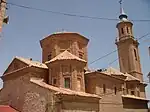 Templo del Pilar.
Templo del Pilar.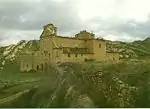 Convento del Desierto.
Convento del Desierto.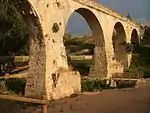 Los Arcos.
Los Arcos.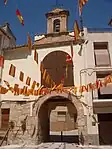 Arco de San Roque.
Arco de San Roque.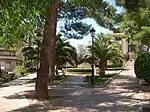 Glorieta Oliva Gasque.
Glorieta Oliva Gasque.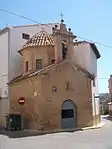 El Humilladero.
El Humilladero.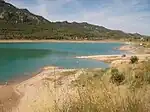 Pantano de Calanda.
Pantano de Calanda.
Archaeology: Camino de la Vega de Albalate
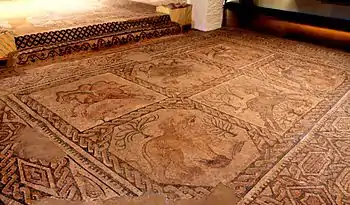 Camino de Albalate (1): Roman mosaic.
Camino de Albalate (1): Roman mosaic..JPG.webp) Camino de Albalate (2): Roman mosaic, detail.
Camino de Albalate (2): Roman mosaic, detail..JPG.webp) Camino de Albalate (3): Glazed ceramic vessel.
Camino de Albalate (3): Glazed ceramic vessel. Camino de Albalate (4): Landmark memorial.
Camino de Albalate (4): Landmark memorial.
References
- ↑ Municipal Register of Spain 2018. National Statistics Institute.
External links
Wikimedia Commons has media related to Calanda.
This article is issued from Wikipedia. The text is licensed under Creative Commons - Attribution - Sharealike. Additional terms may apply for the media files.
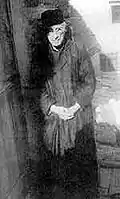

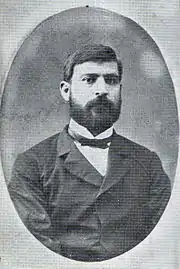
.jpg.webp)
.jpg.webp)
